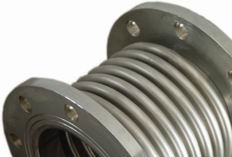- Tel: +44 (0) 208 305 0792
- FAX: +44 (0) 208 858 0101
- info@stoneleigh-eng.com

Pipe Expansion Joints
Please click HERE for general information on Pipe Expansion Joints
We are able to offer a competitive range of Pipe Expansion Joints to satisfy most requirements
For further enquiries please contact us on: +44 (0) 208 305 0792 or email: info@stoneleigh-eng.com
Thermal Expansion Joints, Flexible Connectors, Vibration Isolation and Noise Control

Pipe expansion joints are required in a variety of systems that convey high temperature commodities such as steam or exhaust gases, or to absorb movement and vibration. A common expansion joint for pipe systems is a bellows type. Normally manufactured from metal (most commonly stainless steel), plastic (such as PTFE), or sometimes rubber. A bellows is made up of a series of one or more convolutions, with the shape of the convolution configured to withstand the internal pressures of the pipe, but flexible enough to accept the axial, lateral, and/or angular deflections. Expansion joints are also designed for other applications, for example: noise absorption, anti-vibration, earthquake movement, and building settlement.
Please contact us with your requirements
Pipe Expansion Joints
The expansion joint is an assembly designed to safely absorb the heat-induced expansion and contraction of various construction materials, to absorb vibration, or to allow movement due to ground settlement or earthquakes. They are commonly found between sections of pavements, bridges, railway tracks, piping systems, and other structures.
Throughout the year, building surfaces, concrete slabs, and pipelines will expand and contract due to the warming and cooling through seasonal variation, or due to other heat sources. Before expansion joint gaps were built into these structures, they would crack under the stress induced.
The expansion joint can be as simple as a caulked separation between two sections of the same materials. More recently, expansion joints have been included in the design of, or added to existing, brick exterior veneer walls for similar purposes. In concrete and concrete block ("CMU") construction, the term applied is control joint, but serves a similar purpose.
Pipe Expansion Joints
Pipe expansion joints are necessary in systems that convey high temperature commodities such as steam or exhaust gases, or to absorb movement and vibration. A typical type of expansion joint for pipe systems is a bellows which can be manufactured from metal (most commonly stainless steel), plastic (such as PTFE), or an elastomer such as rubber. A bellows is made up of a series of one or more convolutions, with the shape of the convolution designed to withstand the internal pressures of the pipe, but flexible enough to accept the axial, lateral, and/or angular deflections. Expansion joints are also designed for other criteria, such as noise absorption, anti-vibration, earthquake movement, and building settlement.
Pipe expansion joints are also known as compensators, as they 'compensate' for the thermal movement.
Ducted Air Systems
Expansion joints are required in large ducted air systems to allow fixed pieces of piping to be largely free of stress as thermal expansion occurs. Bends in elbows also can accommodate this. Expansion joints also isolate pieces of equipment such as fans from the rigid ductwork thereby reducing vibration to the ductwork as well as allowing the fan to "grow" as it comes up to the operating air system temperature without putting stress on the fan or the fixed portions of ductwork.
An expansion joint is designed to allow deflection in the axial(compression) or laterally (shear) or angular (bending) deflections. Expansion joints can be non-metallic or metallic (often called bellows type). Non-metallic can be a single ply of rubberized material or a composite made of multiple layers of heat and erosion resistant flexible material. Typical layers are: outer cover to act a gas seal, a corrosion resistant material such as Teflon, a layer of fiberglass to act as an insulator and to add durability, several layers of insulation to ensure that the heat transfer from the flue gas is reduced to the required temperature and an inside layer.
A bellows is made up of a series of one or more convolutions of metal to allow the axial, lateral or angular deflection required.


